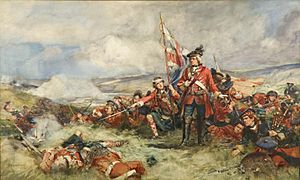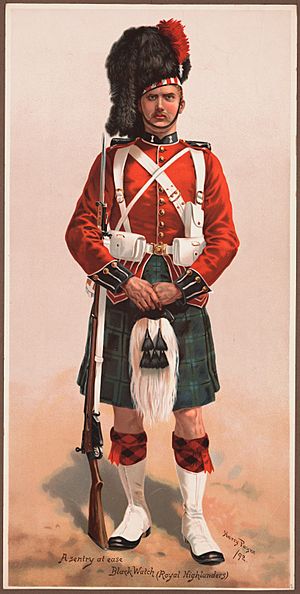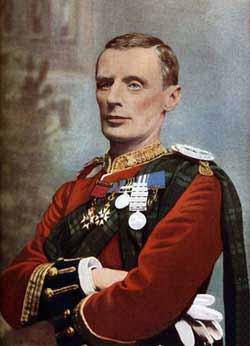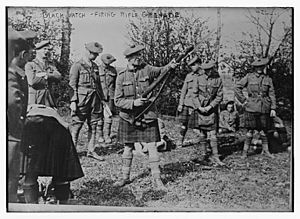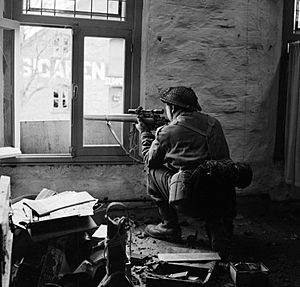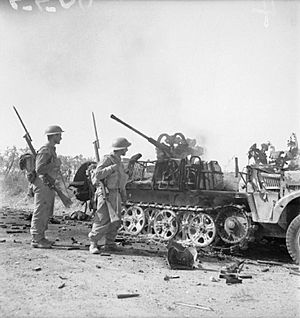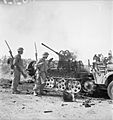Black Watch facts for kids
Quick facts for kids Black Watch, 3rd Battalion, Royal Regiment of Scotland |
|
|---|---|
 |
|
| Founded | 1 July 1881 – present |
| Country | |
| Branch | |
| Type | Line infantry |
| Role | Light infantry |
| Size | Battalion 628 personnel |
| Part of | 51st Infantry Brigade and Headquarters Scotland |
| Garrison/HQ | RHQ – Balhousie Castle Battalion – Fort George, Inverness |
| Nickname(s) | "The Forty Twa" "Black Jocks" (slang term used by members of other regiments) "Ladies from Hell" |
| Motto(s) | Nemo me impune lacessit (Latin) "No One Provokes Me with Impunity" |
| March |
|
| Anniversaries | Red Hackle Day (5 January) |
| Battle honours | see below |
| Commanders | |
| Royal Colonel | King Charles III |
| Insignia | |
| Tactical Recognition Flash |  |
| Hackle | Red |
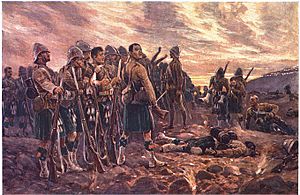
The Black Watch, 3rd Battalion, Royal Regiment of Scotland (3 SCOTS) is a famous infantry (foot soldiers) battalion of the Royal Regiment of Scotland. This regiment was formed in 1881. It brought together two older units: the 42nd (Royal Highland) Regiment of Foot (The Black Watch) and the 73rd (Perthshire) Regiment of Foot. From 1881 to 2006, it was known by slightly different names. Since 2017, it has been part of the Scottish, Welsh and Irish Division.
Contents
What Does "Black Watch" Mean?
The exact reason for the name "Black Watch" is not fully known. In 1725, after a rebellion, King George I allowed General George Wade to create six "watch" companies. These companies were meant to patrol the Scottish Highlands. Their job was to disarm Highlanders, stop crime, and catch rebels.
The force was known in Gaelic as Am Freiceadan Dubh, which means "the dark" or "black watch."
Why the Name "Black Watch"?
There are a few ideas about where the name came from:
- Dark Uniforms: The companies wore dark tartan uniforms, which might have led to the "black" part of the name.
- "Black Hearts": Some people thought the name referred to the "black hearts" of the soldiers. These soldiers sided with the government against those who wanted to keep the old Highland ways.
- Stopping "Blackmail": Another idea is that the name came from their job of stopping "blackmail." This was when Highlanders demanded payments to protect cattle herds.
A Look at Their History
The Black Watch regiment was officially formed in 1881. The 42nd Regiment became the 1st Battalion, and the 73rd Regiment became the 2nd Battalion.
Early Battles and Wars
The 1st Battalion fought in the Anglo-Egyptian War in 1882. They also saw action in the Mahdist War in Sudan in 1884 and 1885. Later, they were sent to South Africa for the Second Boer War. The 2nd Battalion also fought in the Second Boer War, suffering many losses at the Battle of Magersfontein in 1899.
The First World War (1914-1918)
The Black Watch played a huge role in the First World War. Many battalions were formed, including regular army units and new volunteer units.
Fighting on the Western Front
The 1st Battalion fought on the Western Front in France and Belgium. They were involved in major battles like the Retreat from Mons and the First Battle of the Marne in 1914. They also took part in the advance to the Hindenburg Line in 1918.
The 2nd Battalion also served on the Western Front before moving to Mesopotamia (modern-day Iraq). There, they fought in the siege of Kut and the fall of Baghdad. Later, they moved to Palestine and fought in the Battle of Megiddo.
Volunteer Battalions
Many volunteer battalions, like the 1/4th, 1/5th, 1/6th, and 1/7th, also fought bravely on the Western Front. They faced tough battles like Battle of Neuve Chapelle and Battle of Festubert.
Kitchener's Army: New Battalions
The 8th and 9th Service Battalions were part of "Kitchener's Army." These were new units made up of volunteers.
- 8th Battalion: This battalion was formed quickly in 1914. They were the first of Lord Kitchener's new army divisions. They fought in many key battles on the Western Front, including the Battle of Loos in 1915, where they suffered heavy losses.
- 9th Battalion: Also formed in 1914, this battalion trained and then moved to France. They also fought at the Battle of Loos, losing many soldiers. They continued to fight in major battles like the Battle of Delville Wood and the Battle of Pilckem Ridge.
- 10th Battalion: This battalion was formed in Perth in 1914. They trained in England before being sent to France. Later, they were deployed to Salonika (Greece) to fight on the Macedonian front. They took part in the Battle of Doiran in 1917.
The Second World War (1939-1945)
The Black Watch continued to serve with courage in the Second World War.
Regular Army in WWII

The 1st Battalion went to France in 1939. They were captured at St Valery-en-Caux during the Battle of France. The battalion was reformed and later fought in North Africa, including the Second Battle of El Alamein. They also took part in the Allied invasion of Sicily and the Normandy landings in 1944. They saw action in the Battle for Caen and the Battle of the Bulge.
The 2nd Battalion served in Palestine and East Africa. They fought in Crete and took part in the break out from Tobruk in North Africa.
Territorial Army in WWII
Several Territorial Army battalions also served. The 4th Battalion helped with the Dunkirk evacuation. The 5th Battalion fought at the Second Battle of El Alamein and in the Normandy landings. The 6th and 7th Battalions also took part in the Dunkirk evacuation and fought in North Africa and Italy. The 7th Battalion was one of the first to cross the River Rhine in 1945.
After the Wars
After World War II, the 2nd Battalion was sent to India in 1945. They were there when India and Pakistan became independent in 1947. The regiment also helped stop the Royal Indian Navy mutiny in Karachi.
The Black Watch earned honors in the Korean War in 1952. They also helped deal with the Mau Mau Uprising in Kenya in 1953 and violence in Cyprus in the late 1950s.
In 1963, nine pipers from the Black Watch played at the funeral of US President John F. Kennedy. The regiment was so well-known that in 1964, US President Lyndon Johnson asked for them to be sent to Vietnam, but this request was refused.
The Black Watch also served in Northern Ireland during a period of conflict known as the Troubles.
Hong Kong Handover
In 1997, the Black Watch was the last British military unit to leave Hong Kong. They played an important part in the ceremony when Hong Kong was returned to China.
The Black Watch Today
Recent Operations
During the 2003 Iraq War, the Black Watch fought in the attack on Basra. In 2004, they were sent to Iraq again. They were moved to a dangerous area called the "Triangle of Death." Here, they faced many attacks from insurgents.
In 2006, the Black Watch joined five other Scottish regiments to form the Royal Regiment of Scotland. This was done to make the army more efficient. The Black Watch became the 3rd Battalion of this new regiment.
In 2009, parts of the battalion carried out a large air assault operation in Afghanistan. This was called Operation Panther's Claw. They attacked a Taliban stronghold and secured important crossing points.
What's Next for the Black Watch?
The battalion is currently based at Fort George in Scotland. They are equipped with Foxhound light armoured vehicles. They are part of the 51st Infantry Brigade and Headquarters Scotland.
How the Regiment is Organized
The Black Watch is set up as a light infantry battalion.
- Headquarters: Their main office is at Fort George in Inverness.
- Active Battalion: This is the main fighting unit, also at Fort George. It has a Headquarters Company, three Light Infantry Companies, and a Fire Support Company.
- Army Reserve: The 7th Battalion of the Royal Regiment of Scotland includes a Black Watch Company in Dundee.
- Museum: The Black Watch Regimental Museum is located at Balhousie Castle in Perth.
Uniform and Traditions
The Black Watch mainly recruits from areas like Fife, Dundee, Angus, and Perth and Kinross. A special tradition is that the battalion is allowed to keep its famous red hackle (a feather plume) on their Tam o'Shanter hats.
Famous People Who Served
Many notable individuals have served with the Black Watch, including:
- Alfred Anderson, Scotland's last surviving World War I veteran.
- Jim Baxter, a famous Scottish footballer.
- Fergus Bowes-Lyon, the older brother of Queen Elizabeth The Queen Mother.
- Lachlan Macquarie, an early Governor of New South Wales, Australia.
- Rory Stewart, a Scottish politician and professor.
- Archibald Wavell, a British field marshal in World War II.
Victoria Cross Winners
The Victoria Cross is the highest award for bravery in the British military. Several Black Watch soldiers have received this honor:
- Francis Edward Henry Farquharson, John Simpson, Alexander Thompson, James Davis, Edward Spence, William Gardner, Walter Cook, Duncan Millar (for actions during the Indian Mutiny).
- Samuel McGaw (Ashanti War).
- Thomas Edwards (Egyptian Campaigns).
- John Ripley, David Finlay, Charles Melvin, Lewis Evans (First World War).
- Bill Speakman (Korean War).
Battle Honors
The Black Watch has earned many battle honors, which are special awards for their bravery in battles. These include honors from:
- Early wars like Guadaloupe 1759, Martinique 1762, and South Africa 1846–47.
- The Great War (First World War), with honors from many famous battles like Ypres 1914, Somme 1916, and Arras 1917.
- The Second World War, including honors from Dunkirk 1940, El Alamein, Normandy 1944, and the Rhine crossing.
- More recent conflicts like The Hook 1952 (Korea), Al Basrah (Iraq 2003), and the Second Battle of Fallujah (Iraq 2004).
Royal Connections
The Black Watch has had close ties to the Royal Family:
- Colonels-in-Chief:
- 1912: King George V
- 1937: Queen Elizabeth The Queen Mother
- 2003: King Charles III
Alliances with Other Units
The Black Watch has special connections with military units in other countries:
- Australia: The Royal Queensland Regiment and The Royal New South Wales Regiment.
- Canada: The Black Watch (Royal Highland Regiment) of Canada, 42nd Field Artillery Regiment, and The Prince Edward Island Regiment.
- South Africa: Solomon Mahlangu Regiment.
- Sri Lanka: Gemunu Watch.
- United Kingdom: HMS Montrose (a Royal Navy ship).
Canada has its own Black Watch regiment, formed in 1862, which fought in both World Wars. New Zealand also had a Scottish regiment allied with the Black Watch until 2013.
Images for kids
-
The Black Watch on Parade at Gibraltar.
See also
- Lovat Scouts
- Foreign military units at the state funeral of John Kennedy



